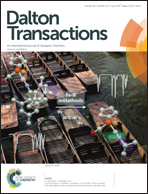Enhanced magneto-dielectric coupling in multiferroic Fe and Gd codoped PbTiO3 nanorods synthesized via microwave assisted technique†
Abstract
The quest for new multiferroic materials is on the rise due to their potential application in spintronics and futuristic multiple state memory devices. Here we report the microwave synthesis of iron/gadolinium co-doped PbTiO3 nanorods, which display multiferroic behavior. Both the undoped and doped PbTiO3 samples have been characterized using powder X-ray diffraction, energy dispersive X-ray spectroscopy (EDS) and X-ray photoelectron spectroscopy (XPS) techniques. The morphology of the samples has been studied using transmission electron microscopy (TEM) and high resolution transmission electron microscopy (HRTEM), which confirmed the formation of nanorods. The substitution of Fe ions for Ti and Gd ions for Pb enhances the ferromagnetic and ferroelectric properties of this system. The reasons for this observation have been explored in detail. The ferroelectric, magnetic and magneto-capacitive measurements at room temperature substantiate the multiferroic nature of the codoped samples with significant magnetoelectric coupling observed in case of nano PbTiO3:Gd3+(0.5%):Fe3+(5%).


 Please wait while we load your content...
Please wait while we load your content...